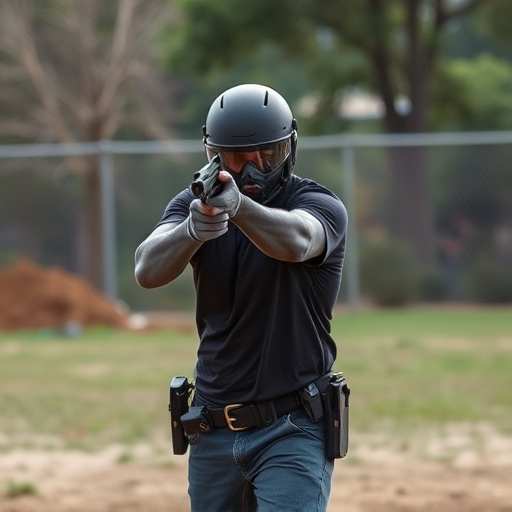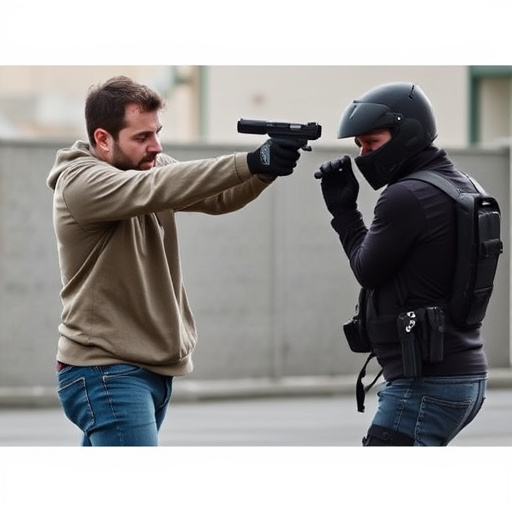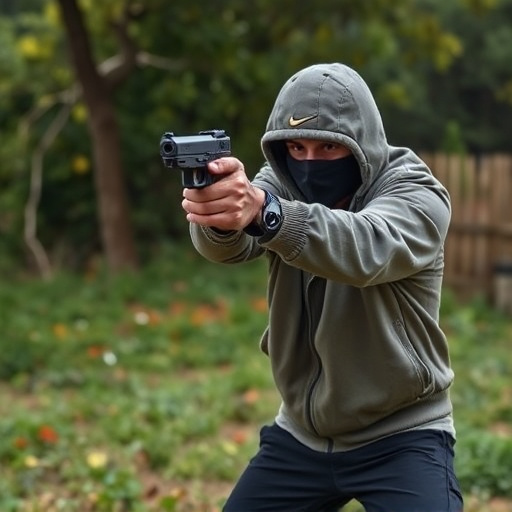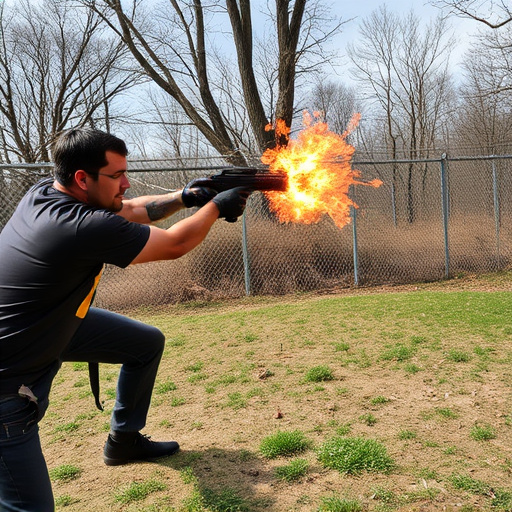Stun weapons, crucial for personal defense, are categorized as projectile (like tasers) or contact (stun guns). Projectiles offer a safer, tactical range but carry misfire risks, while contacts require direct contact and pose higher harm if not properly deployed. Legalities vary globally, with safety guidelines emphasizing correct charging, storage, and adherence to local laws. Effective stun gun charging involves inspecting for damage, using the provided charger, waiting for full charge, and regular maintenance. Law enforcement uses both types for distinct purposes, with proper charging vital for optimal performance and safety in critical situations.
In the realm of personal defense, stun weapons have emerged as game-changers. This article delves into the intricacies of two prominent types: projectile and contact stun devices, exploring their mechanisms, advantages, and legal considerations. We provide a comprehensive guide on ‘how to charge a stun gun properly’, essential for optimal performance. Beyond theory, we examine real-world applications, shedding light on their effectiveness in various scenarios. Understand the key differences and make informed choices for your safety needs.
- Understanding Projectile and Contact Stun Weapons: Definitions and Key Differences
- Mechanism of Action: How Do They Work?
- Advantages and Disadvantages: A Comparative Analysis
- Legal Considerations: Regulations and Safety Guidelines
- Charging a Stun Gun Properly: Step-by-Step Guide
- Real-World Applications: Use Cases and Effectiveness
Understanding Projectile and Contact Stun Weapons: Definitions and Key Differences

Stun weapons are a significant category in personal defense, with two primary types: projectile and contact. Projectile stun devices, such as stun guns or shotguns firing specialized non-lethal rounds, operate by delivering an electric shock to the target from a distance. These weapons use kinetic energy to impact the body and trigger the stun effect, making them effective for self-defense against aggressive assailants.
Contact stun weapons, on the other hand, directly make physical contact with the target’s body. This category includes devices like electroshock batons or tasers that deploy probes or darts to make direct electrical contact. The advantage of contact stun weapons is their ability to incapacitate without causing permanent harm. Proper use and understanding of these devices, including how to charge a stun gun properly, are crucial for ensuring effectiveness and safety during self-defense scenarios.
Mechanism of Action: How Do They Work?

Projectile and contact stun weapons operate on distinct mechanisms, each employing unique strategies to incapacitate targets. Projectile stun guns, such as stun darts or rounds, rely on speed and impact to deliver a charge. These weapons fire a small, high-voltage projectile that makes physical contact with the target’s skin, disrupting nerve signals and causing muscle spasms. The velocity at impact ensures a strong jolt, rendering the individual temporarily stunned.
In contrast, contact stun devices, like stun batons or electric tasers, utilize direct electrical current to stun. These tools have probes or barbs that make contact with the target’s body, allowing for the transmission of an electric shock. The current disrupts the target’s nervous system, leading to muscle paralysis and loss of balance. Proper charging of these devices is crucial; stun guns, for instance, require regular maintenance and proper battery insertion to ensure optimal performance when needed.
Advantages and Disadvantages: A Comparative Analysis

Advantages and Disadvantages: A Comparative Analysis
Projectile stun weapons, such as tasers, offer a non-lethal means of self-defense by temporarily incapacitating targets through electrical impulse. Their primary advantage lies in their range—officers or individuals can disable a threat from a distance, providing a safer option for de-escalation. Moreover, proper use ensures minimal physical contact, making them less likely to cause secondary injuries. However, drawbacks include the potential for misfire or accidental discharge, which could lead to unintended consequences. Additionally, some critics argue that they may not always be effective against larger or more aggressive individuals.
Contact stun devices, like stun guns, require direct or close contact with the target. A significant advantage is their simplicity; users simply point and press the trigger, making them user-friendly for those without extensive training. They are also generally more powerful, capable of rendering a person unconscious for an extended period. However, this direct approach increases the risk of physical harm to the user and bystanders if not deployed correctly. Proper training on how to charge stun gun properly is essential to mitigate these risks. Furthermore, they may not be suitable for situations demanding non-lethal force but requiring a quick response, as they lack the tactical distance of projectile weapons.
Legal Considerations: Regulations and Safety Guidelines

The legality of stun weapons, be it projectile or contact-based, varies greatly across jurisdictions. Before considering acquiring a stun device, understanding local laws and regulations is paramount. Some countries and states permit the open carry of stun guns for self-defense purposes, while others restrict their use to law enforcement agencies only. Non-lethal weapons, including stun guns and tasers, are subject to specific safety guidelines that dictate how they can be used, stored, and charged properly.
Proper charging of a stun gun is not just about ensuring its functionality; it’s also a crucial step in maintaining safety. Users must follow the manufacturer’s instructions regarding charging procedures, intervals, and storage practices to prevent accidental activation or malfunctions. In many regions, carrying a stun device comes with responsibilities, including mandatory training, permits, and registration, which can vary based on the type of weapon and local laws. Adhering to these legal considerations is essential for personal safety and to avoid legal repercussions.
Charging a Stun Gun Properly: Step-by-Step Guide

Stun guns, also known as electroshock weapons, require proper charging to ensure their effectiveness and safety. Charging a stun gun is a straightforward process, but it’s crucial to follow specific steps to avoid any potential issues. Here’s a step-by-step guide on how to charge your stun gun properly:
1. Inspect the Stun Gun: Before charging, check if there are any visible signs of damage or wear. Ensure all parts are securely attached and functioning correctly. Make sure the device is turned off and unplugged from any power source.
2. Connect the Charger: Locate the charging port on your stun gun, usually a small opening with a specific shape or label. Insert the charger provided by the manufacturer into the port. Ensure it fits snugly to prevent accidental disconnection.
3. Plug in and Activate: Connect the other end of the charger to a compatible power outlet. Turn on the charger and wait for the stun gun to fully charge. Some models may have an LED indicator that shows the charging status, while others might require you to use a voltmeter to confirm full charge.
4. Remove and Store: Once charged, unplug the stun gun from the charger and store it in a safe, dry place. Keep it out of reach of children and unauthorized individuals. Regularly recharge your stun gun according to the manufacturer’s recommendations to maintain optimal performance.
Real-World Applications: Use Cases and Effectiveness

In real-world applications, both projectile and contact stun weapons have distinct use cases and effectiveness levels. Stun guns, also known as electroshock weapons, are designed to temporarily incapacitate a target through electric current. They are often used by law enforcement and security personnel for crowd control or to subdue resistant individuals without causing permanent harm. The proper charging of a stun gun is crucial; it involves following manufacturer guidelines to ensure optimal performance and safety. This includes regular maintenance, such as checking battery levels and cleaning the device to prevent buildup of static electricity that could interfere with its operation.
Projectile stun weapons, like tasers, discharge electrical probes towards a target, delivering a powerful shock upon impact. These devices are particularly useful in situations where a subject is at a distance or moving swiftly. However, their effectiveness can be hindered by weather conditions, physical barriers, and the target’s body composition. Unlike stun guns that require direct contact, tasers offer a more versatile approach but may not always guarantee immediate neutralization. Understanding how to charge and maintain these devices properly is essential for optimal performance in critical situations where every second counts.
In exploring the distinctions between projectile and contact stun weapons, this article has highlighted their unique mechanisms, advantages, and drawbacks. Understanding these differences is key in making an informed choice based on individual needs and legal frameworks. Additionally, proper charging techniques, as outlined in our step-by-step guide, ensure optimal performance and safety when using a stun gun. By staying informed about legal considerations and practical applications, folks can harness the power of stun weapons responsibly while enhancing their personal security.
